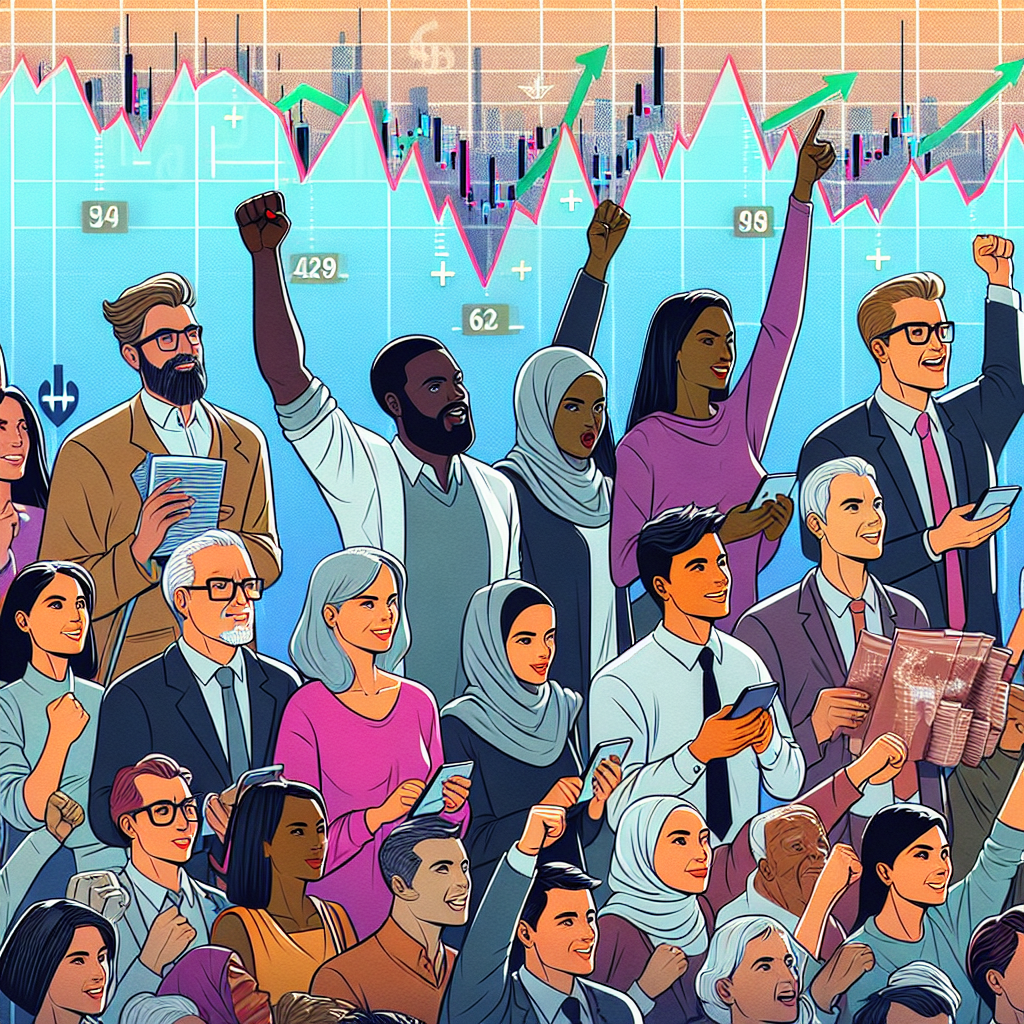-
Table of Contents
- Investors Keep Buying Despite Economic Pessimism Reaching New Heights
- The Current State of Economic Pessimism
- Factors Driving Investor Optimism
- 1. Long-Term Investment Horizons
- 2. Diversification Strategies
- 3. Technological Advancements
- 4. Central Bank Policies
- Case Studies: Investor Behavior During Economic Downturns
- 1. The Dot-Com Bubble (2000-2002)
- 2. The 2008 Financial Crisis
- 3. The COVID-19 Pandemic
- Psychological Factors Influencing Investor Behavior
- 1. Fear of Missing Out (FOMO)
- 2. Herd Mentality
- 3. Overconfidence Bias
- Strategies for Navigating Economic Uncertainty
- 1. Dollar-Cost Averaging
- 2. Value Investing
- 3. Defensive Investments
- Conclusion
Investors Keep Buying Despite Economic Pessimism Reaching New Heights

In an era marked by economic uncertainty and widespread pessimism, one might expect investors to retreat to the sidelines, waiting for clearer skies. However, contrary to this expectation, investors continue to pour money into the markets. This paradoxical behavior raises several questions: Why are investors buying despite the gloomy economic outlook? What factors are driving this seemingly irrational exuberance? This article delves into these questions, providing a comprehensive analysis of the current investment landscape.
The Current State of Economic Pessimism
Economic pessimism has reached unprecedented levels, driven by a confluence of factors:
- Global Inflation: Rising prices for goods and services have eroded purchasing power, leading to concerns about long-term economic stability.
- Geopolitical Tensions: Ongoing conflicts and trade wars have disrupted global supply chains and created an atmosphere of uncertainty.
- Pandemic Aftershocks: The COVID-19 pandemic has left lasting scars on economies worldwide, with many sectors still struggling to recover.
- Interest Rate Hikes: Central banks, in an effort to combat inflation, have raised interest rates, making borrowing more expensive and potentially stifling economic growth.
Despite these challenges, investors are not shying away from the markets. To understand this phenomenon, we need to explore the underlying motivations and strategies that are driving investment decisions.
Factors Driving Investor Optimism
1. Long-Term Investment Horizons
Many investors are adopting a long-term perspective, focusing on the potential for future growth rather than short-term volatility. Historical data supports this approach:
- Stock Market Resilience: Over the past century, the stock market has consistently rebounded from downturns, often reaching new highs within a few years.
- Compounding Returns: Long-term investments benefit from the power of compounding, which can significantly enhance returns over time.
For example, the S&P 500 has delivered an average annual return of around 10% since its inception, despite numerous economic crises along the way.
2. Diversification Strategies
Investors are increasingly diversifying their portfolios to mitigate risk. This strategy involves spreading investments across various asset classes, sectors, and geographies:
- Asset Classes: By investing in a mix of stocks, bonds, real estate, and commodities, investors can reduce the impact of a downturn in any single market.
- Sectors: Diversifying across different industries, such as technology, healthcare, and consumer goods, helps to balance sector-specific risks.
- Geographies: Global diversification allows investors to capitalize on growth opportunities in emerging markets while hedging against regional economic downturns.
Case studies have shown that diversified portfolios tend to perform better during periods of economic uncertainty. For instance, during the 2008 financial crisis, diversified portfolios experienced smaller losses compared to those heavily concentrated in equities.
3. Technological Advancements
Technological innovation continues to drive economic growth and create new investment opportunities. Key areas of focus include:
- Artificial Intelligence (AI): AI is revolutionizing industries from healthcare to finance, offering significant growth potential for investors.
- Renewable Energy: The transition to clean energy sources is creating new markets and investment opportunities in solar, wind, and battery technologies.
- Biotechnology: Advances in biotechnology are leading to breakthroughs in medical treatments and personalized medicine, attracting substantial investment.
For example, the global AI market is projected to grow from $58.3 billion in 2021 to $309.6 billion by 2026, representing a compound annual growth rate (CAGR) of 39.7%. Investors are keen to capitalize on such high-growth sectors.
4. Central Bank Policies
Despite recent interest rate hikes, central banks continue to play a crucial role in supporting the markets:
- Quantitative Easing (QE): Central banks have injected trillions of dollars into the financial system through QE programs, providing liquidity and supporting asset prices.
- Forward Guidance: By communicating their policy intentions clearly, central banks help to stabilize market expectations and reduce uncertainty.
For instance, the Federal Reserve’s QE programs have been instrumental in supporting the U.S. stock market during periods of economic stress. Investors are betting that central banks will continue to provide support if needed.
Case Studies: Investor Behavior During Economic Downturns
1. The Dot-Com Bubble (2000-2002)
The dot-com bubble saw a dramatic rise and fall in technology stocks. Despite the subsequent market crash, many investors who stayed the course and continued to invest in technology companies eventually reaped substantial rewards. Companies like Amazon and Google, which emerged stronger from the downturn, have delivered astronomical returns for long-term investors.
2. The 2008 Financial Crisis
The 2008 financial crisis was one of the most severe economic downturns in recent history. However, investors who maintained their positions and continued to invest during the crisis saw significant gains in the following years. The S&P 500, for example, more than tripled in value from its 2009 lows to its pre-pandemic highs in 2020.
3. The COVID-19 Pandemic
The COVID-19 pandemic caused a sharp market decline in early 2020. Yet, investors who remained invested or bought into the market during the downturn experienced a rapid recovery. The S&P 500 reached new all-time highs within months, driven by unprecedented fiscal and monetary stimulus measures.
Psychological Factors Influencing Investor Behavior
1. Fear of Missing Out (FOMO)
The fear of missing out (FOMO) is a powerful psychological driver that compels investors to buy into the market, even during periods of economic pessimism. The rapid recovery of markets following recent downturns has reinforced this behavior, as investors fear missing out on potential gains.
2. Herd Mentality
Herd mentality refers to the tendency of individuals to follow the actions of a larger group. When influential investors or institutions continue to buy, others are likely to follow suit, creating a self-reinforcing cycle of investment activity.
3. Overconfidence Bias
Overconfidence bias leads investors to overestimate their ability to predict market movements and make successful investment decisions. This bias can result in continued buying, even in the face of negative economic indicators.
Strategies for Navigating Economic Uncertainty
1. Dollar-Cost Averaging
Dollar-cost averaging involves investing a fixed amount of money at regular intervals, regardless of market conditions. This strategy helps to mitigate the impact of market volatility and reduces the risk of making poorly timed investment decisions.
2. Value Investing
Value investing focuses on identifying undervalued stocks with strong fundamentals. By buying these stocks at a discount, investors can potentially achieve significant returns when the market eventually recognizes their true value.
3. Defensive Investments
Defensive investments, such as utility stocks, consumer staples, and healthcare companies, tend to perform well during economic downturns. These sectors provide essential goods and services that remain in demand regardless of economic conditions.
Conclusion
Despite the prevailing economic pessimism, investors continue to buy into the markets, driven by a combination of long-term perspectives, diversification strategies, technological advancements, and central bank policies. Historical case studies demonstrate that staying invested during downturns can yield substantial rewards over time. Psychological factors, such as FOMO, herd mentality, and overconfidence bias, also play a significant role in driving investor behavior.
To navigate economic uncertainty, investors can adopt strategies such as dollar-cost averaging, value investing, and focusing on defensive investments. By understanding the underlying motivations and strategies that drive investment decisions, investors can make informed choices and potentially achieve long-term financial success.
In summary, while economic pessimism may be at an all-time high, the resilience and adaptability of investors continue to shape the financial markets. By staying informed and adopting prudent investment strategies, investors can navigate the challenges and seize opportunities in an ever-changing economic landscape.








